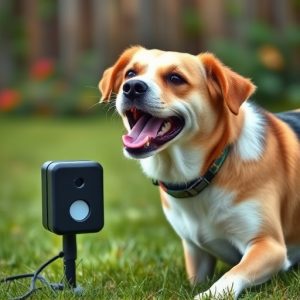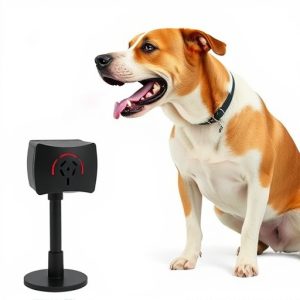Sound Wave Pet Control: Humane Training with Electronic Repellents
Sound wave technology offers a humane training mode for pets using electronic repellents that emit u…….
Sound wave technology offers a humane training mode for pets using electronic repellents that emit ultrasonic or infrasonic waves to encourage desired behaviors. Unlike harsh electronic repellents, these devices are safe and non-invasive, promoting positive reinforcement training while strengthening the bond between pets and owners. With adjustable intensity and frequency, they're highly effective in managing specific pet needs, such as excessive barking or jumping, without causing stress or anxiety. Implementing humane training modes like electronic repellents is crucial for positive pet behavior modification, but safety precautions and ethical considerations are vital to ensure pet well-being.
“Unleash the power of sound for effective pet behavior control with humane training methods. This comprehensive guide explores innovative solutions through sound wave technology, revolutionizing how we train our furry friends. From understanding the science behind electronic repellents to their advantages over traditional methods, we delve into safe and ethical applications. Discover how these tools can modify behaviors without harm, catering to various pet needs. By implementing humane training modes, pet owners can achieve desired outcomes while ensuring well-being.”
- Understanding Sound Wave Technology for Pet Training
- Advantages of Electronic Repellents Over Traditional Methods
- Implementing Humane Training Modes for Different Pet Behaviors
- Safety Precautions and Ethical Considerations in Sound Wave Pet Behavior Control
Understanding Sound Wave Technology for Pet Training
Sound wave technology has emerged as a innovative and humane training mode for pets, offering alternative solutions to traditional methods. This technology utilizes specific sound frequencies to communicate with animals, encouraging desired behaviors while mitigating negative reinforcement. Unlike electronic repellents that rely on shocks or noises to deter pets, sound wave trainers utilize ultrasonic or infrasonic waves imperceptible to humans but effective in guiding pet behavior.
By emitting these sounds, devices can motivate pets to stop unwanted actions, such as jumping on furniture or barking excessively. The technology is designed to be safe and non-invasive, promoting positive reinforcement training that strengthens the bond between pets and their owners. This humane approach has gained popularity among responsible pet owners seeking effective yet gentle methods for training and behavior management.
Advantages of Electronic Repellents Over Traditional Methods
In the realm of pet behavior management, the shift from traditional methods to electronic repellents offers several significant advantages. One of the primary benefits is their humane training modes. Unlike older techniques that relied on punishment or negative reinforcement, electronic repellets use gentle stimuli like static or vibration to guide pets without causing them harm. This not only promotes a more positive learning environment but also reduces stress and anxiety in animals.
Additionally, electronic repellents are highly effective and versatile. They can be tailored to specific pet needs, adjusting the intensity and frequency of the stimulus as the animal learns and adapts. This flexibility allows for precise training, ensuring pets understand the desired behavior without being overwhelmed. Moreover, these devices often come with remote controls, giving caregivers more control over the training process from a distance, making them ideal for addressing unwanted behaviors in active or hard-to-reach areas.
Implementing Humane Training Modes for Different Pet Behaviors
Implementing Humane Training Modes for Different Pet Behaviors
When it comes to training pets, especially dogs and cats, it’s essential to use humane training modes that promote positive reinforcement while minimizing stress and punishment. Electronic repellent systems, a modern approach in pet behavior control, offer various settings tailored for different behaviors. For instance, low-frequency sounds or vibrations can be used to gently correct unwanted actions like excessive barking or jumping on furniture without causing harm. These devices allow pet owners to set specific triggers, ensuring the animal associates certain behaviors with pleasant or unpleasant sensations.
Humane training modes also include clicker training and reward-based systems. Clicker trainers emit a distinct sound to mark the exact moment a desired behavior is displayed, followed by a treat or praise. This technique strengthens positive associations in pets’ minds. Similarly, reward-based training involves offering treats or affection whenever a pet exhibits the desired behavior, encouraging them to repeat it voluntarily. By combining these humane methods with consistent, gentle guidance, pet owners can effectively manage and shape their animals’ behaviors while fostering a strong bond based on trust and respect.
Safety Precautions and Ethical Considerations in Sound Wave Pet Behavior Control
In the pursuit of innovative pet behavior control methods, it’s paramount to address safety precautions and ethical considerations. Sound wave technology, while offering potential solutions, must be employed with caution to ensure the well-being and comfort of pets. Using electronic repellents that emit ultrasonic sounds or specific frequency ranges requires careful calibration to avoid any physical harm or distress to animals. These humane training modes should be designed to disrupt unwanted behaviors without causing pain or lasting psychological effects.
Ethical implications arise from the potential for misuse and the need for clear, evidence-based guidelines. The effectiveness of sound wave pet behavior control must be rigorously tested and verified to ensure it’s not just a temporary fix but a safe, long-term solution. Pet owners, trainers, and researchers should collaborate to establish standards that promote responsible use, respect animal welfare, and uphold the dignity of pets in our care.
Sound wave pet behavior control offers a modern, non-violent approach to training, utilizing electronic repellents that target specific behaviors. By leveraging humane training modes, pet owners can encourage desired actions without resorting to traditional, often harsh methods. As this technology continues to evolve, understanding its applications and implementing them responsibly is key. Safety precautions and ethical considerations must guide the use of sound wave devices, ensuring they enhance, not harm, our beloved pets’ well-being.


